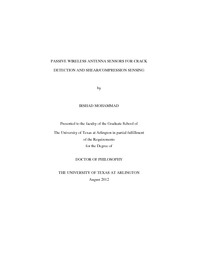
ATTENTION: The works hosted here are being migrated to a new repository that will consolidate resources, improve discoverability, and better show UTA's research impact on the global community. We will update authors as the migration progresses. Please see MavMatrix for more information.
Show simple item record
| dc.contributor.author | Mohammad, Irshad | en_US |
| dc.date.accessioned | 2013-03-20T19:12:25Z | |
| dc.date.available | 2013-03-20T19:12:25Z | |
| dc.date.issued | 2013-03-20 | |
| dc.date.submitted | January 2012 | en_US |
| dc.identifier.other | DISS-11834 | en_US |
| dc.identifier.uri | http://hdl.handle.net/10106/11601 | |
| dc.description.abstract | Despite the fact that engineering components and structures are carefully designed against fatigue failures, 50 to 90% of mechanical failures are due to fatigue crack formation. The severity of the failure depends on both the crack length and its orientation with respect to the loading direction. Many types of sensors are available that can detect fatigue crack propagation. But, crack orientation detection has been rarely reported in the literature. We evaluated a patch antenna sensor capable of detecting crack propagation as well as crack orientation changes. The aim of the sensors would be to evaluate the real-time health condition of metallic structures to avoid catastrophic failures. The proposed crack sensing system consists of a dielectric substrate with a ground plane on one side of the substrate and an antenna patch printed on the other side of the substrate. The ground plane and the antenna patch, both conductive in nature, form an electromagnetic resonant cavity that radiates at distinct frequencies. The frequencies are monitored to evaluate the condition of cracks. A wireless sensor array can be realized by implementing a wireless interrogation unit. The scientific merits of this research are: 1) high sensitivity: it was demonstrated that the antenna sensors can detect crack growth with a sub-millimeter resolution; 2) passive wireless operation: based on microstrip antennas, the antenna sensors encode the sensing information in the backscattered antenna signal and thus can transmit the information without needing a local battery; 3) thin and conformal: the entire sensor unit is less than a millimeter thick and highly conformal; 4) crack orientation detection: the crack orientation on the structure can be precisely evaluated based on a single parameter, which only few sensors can accomplish. In addition to crack detection, the patch antenna sensors are also investigated for measuring shear and pressure forces, with an aim to study the formation, diagnostics and prevention of foot ulcers in diabetic patients. The scientific merits of this proposed research are: 1) simultaneous shear/pressure measurement: current smart shoe technology can only measure shear and pressure separately due to the size of the shear sensor. The proposed sensor can measure shear and pressure deformation simultaneously; 2) high sensitivity and spatial resolution: these sensors are very sensitive and have compact size that enables measuring stress distribution with fine spatial resolution. | en_US |
| dc.description.sponsorship | Huang, Haiying | en_US |
| dc.language.iso | en | en_US |
| dc.publisher | Mechanical Engineering | en_US |
| dc.title | Passive Wireless Antenna Sensors For Crack Detection And Shear/compression Sensing | en_US |
| dc.type | Ph.D. | en_US |
| dc.contributor.committeeChair | Huang, Haiying | en_US |
| dc.degree.department | Mechanical Engineering | en_US |
| dc.degree.discipline | Mechanical Engineering | en_US |
| dc.degree.grantor | University of Texas at Arlington | en_US |
| dc.degree.level | doctoral | en_US |
| dc.degree.name | Ph.D. | en_US |
Files in this item
- Name:
- Mohammad_uta_2502D_11834.pdf
- Size:
- 1.341Mb
- Format:
- PDF
This item appears in the following Collection(s)
Show simple item record


